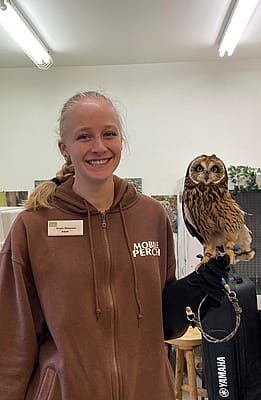
Sunshine for the birds and scrub brushes for me
For the first time in what seems like forever the wind wasn’t blowing yesterday! That’s often something special to celebrate in Wyoming. When you couple that with a relatively warm temperature you have a recipe for a lovely day for the birds. To their delight, I was able to perch them outside for a few hours while I cleaned the mews.
You might be wondering what cleaning the mews entails. Well, it’s a pretty simple process here as we only have four birds to clean up after. The main tasks are to hose and rake the gravel where the feces accumulates (they typically like to stand in the same places so the poop piles up underneath those spots), scrub any “messes” off the walls, clean their bath pans and refill them with fresh water, and, if it’s warm enough, hose off and scrub their perches where they eat.
It typically takes me about 30 minutes to do all four enclosures if I’m all by myself and this is usually a perfect time to perch the birds outside if the weather permits. It’s funny how something as simple as standing out in the sunshine can be such a treat to a wild animal, but it is.
Now, don’t go feeling bad for these birds… It’s not like they spend their days in a dark dungeon, desperately waiting for the chance to get a ray of sunshine. They’re actually quite spoiled. Each bird’s enclosure is at least 8 x 8 x 9 feet, and they all have windows to look out (which is usually where you’ll find them sitting). They never have to stand out in the snow or rain as their windows (which do not have glass but have PVC bars placed vertically for their safety) are covered with plexiglass in the cold months. Peregrine falcon Hayabusa even has her own personal heater to ensure that her mew stays a bit warmer since she would normally have migrated south for winter.
Suli, our turkey vulture, is the truly spoiled bird. She has two mews—one like all the others described above and one inside the food prep area that is heated to 70 degrees. This inside enclosure is where she goes whenever the temperature drops below 35 degrees. With her bald head and migratory habits, she simply can’t handle the cold temperatures like the other birds.
Yep, it’s rough being a bird at the Draper Museum Raptor Experience!
Written By
Melissa Hill
While earning her Bachelor's Degree in Wildlife Management at the University of Wyoming, Melissa began volunteering at Laramie Raptor Refuge and was instantly hooked on birds of prey. Since those early days, she has worked with nearly 70 different raptors at four different raptor education groups in three states. She is a former member of the Education Committee for the International Association of Avian Trainers and Educators (IAATE) and a National Association for Interpretation's Certified Interpretive Guide. When she's not "playing with the birds" she enjoys spending time quilting, crocheting, and exploring the Greater Yellowstone Ecosystem with her non-bird family.













